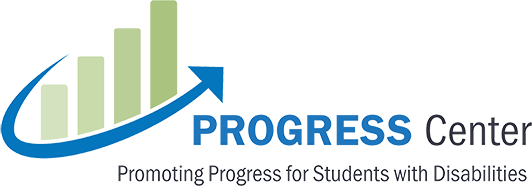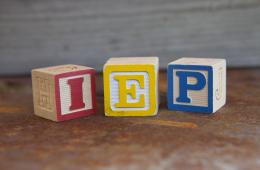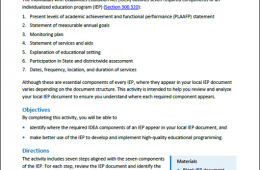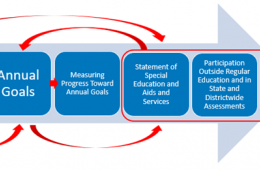Development of High-Quality Educational Programming for Students With Disabilities
High-quality educational programming begins with the development of an individualized education program (IEP) that is reasonably calculated to enable a child with disabilities to make appropriate progress toward challenging goals and objectives in light of the child’s circumstances. The IEP is a written statement that is developed for each eligible child with a disability in accordance with the Individuals with Disabilities Education Act (IDEA) and applicable state laws. The development of an IEP that promotes high-quality educational programming requires ongoing collaboration among special and general educators, local leaders, and families and students.
Present Levels of Academic Achievement and Functional Performance (PLAAFP)
An IEP begins with the development of a statement of present levels of academic achievement and functional performance, or PLAAFPs. In well-developed IEPs, there is a direct relationship between the PLAAFP statement and the other components of the IEP. The PLAAFP statement identifies the student’s needs and provides the baseline for measurable annual goals that are necessary to support the student in accessing and progressing in the general curriculum.
Highlighted Resources
IEP Tip Sheet: PLAAFP Statement
This tip sheet introduces the present levels of academic achievement and functional performance statement, or PLAAFP statement. It includes a brief summary of federal regulations, tips for implementation, and additional resources
Fact Sheet
Promoting Progress for Students with Disabilities: Using the PLAAFP as the Foundation
This webinar introduces the present levels of academic achievement and functional performance statement, or PLAAFP. It includes a review of federal regulations and tips for writing high-quality PLAAFPs.
Webinar
The What and Why of Present Levels of Academic Achievement and Functional Performance (PLAAFP)
This course includes a self-place module that provides an overview of the PLAAFP statement and the critical role it plays in developing a high-quality IEP, highlights tips for developing comprehensive PLAAFP statements, and shares resources to learn more.
Online Module
Measurable Annual Goals
Measurable annual goals are an essential component of the IEP that describe what a student is reasonably expected to accomplish in a 12-month period and are used by IEP teams to determine whether a student is making progress appropriate in light of the child’s circumstances.
Highlighted Resources
IEP Tip Sheet: Measurable Annual Goals
This tip sheet introduces information about developing measurable annual goals. It includes a brief summary of federal regulations, tips for implementation, and additional resources.
Fact Sheet
The What and Why of Measurable Annual Goals
This course includes a self-place module that provides an overview of the measurable annual goals, describes three critical elements of measurable goals, highlights tips for developing goals that promote progress, and shares resources to learn more.
Online Module
Strategies Setting Data-Driven Behavioral Individualized Education Program Goals
This guide provides an overview of behavioral progress monitoring and goal setting to inform data-driven decision making within tiered support models and individualized education programs (IEPs).
User Guide
Promoting Progress: The Role of the Goal
This webinar provides an overview of the IDEA requirements for measurable annual goals, explains the critical role that goals play in the development of a high-quality IEP, shares essential elements for goal writing, and identifies tips for developing goals that promote progress for students with disabilities.
Webinar
Strategies for Setting High-Quality Academic Individualized Education Program Goals
This guide explains how educators can establish IEP goals that are measurable, ambitious, and appropriate in light of the student's circumstances. Four important steps are required for setting a valid goal for individual student performance: selecting a measure, establishing baseline performance, choosing a strategy for setting the goal, and writing a measurable goal.
User Guide
Monitoring Plans
For each annual goal, the IEP team develops a description of how the student’s progress toward the goal will be measured and shared with parents and families.
Highlighted Resources
IEP Tip Sheet: Measuring Progress Toward Annual Goals
This tip sheet discusses measuring progress toward annual goals. It provides a brief summary of federal regulations, tips for implementation, and additional resources.
Fact Sheet
Promoting Progress: Considerations and Resources for Developing the Monitoring Plan for IEP Goals
This webinar provides key considerations for developing a monitoring plan aligned with IDEA requirements and highlights resources for professional learning and selecting technically adequate progress monitoring measures.
Webinar
Selecting Progress Monitoring Tools: Academic and Behavior Progress Monitoring Tools Charts
The academic progress monitoring and behavior progress monitoring tools charts are designed to assist educators and families in becoming informed consumers who can select academic and behavioral progress monitoring tools.
Tools
Specially Designed Instruction, Supplementary Aids and Services, Related Services, and Program Modifications & Supports
To support students in reaching ambitious annual goals, the IEP team uses information from the PLAAFP statement to develop a statement of special education and related services as well as supplementary aids and services. Under IDEA, special education means specially designed instruction or adapting as appropriate the content, methodology, or delivery of instruction to address the unique needs of the child. In some cases, students with disabilities will require related services to benefit from special education. These and other students also may need supplementary aids and services provided in regular education classes, or other education and nonacademic settings, to be educated with children without disabilities to the maximum extent appropriate.
Highlighted Resources
IEP Tip Sheet: Overview of Statement of Services and Aids
The Overview of Statement of Services and Aids Tip Sheet and the four companion tip sheets introduces and provides an overview of the statement of special education, related services, supplementary aids and services, and program modifications that are part of the IEP. These tip sheets include a brief summary of federal regulations and tips for implementation.
Fact Sheet
The What and Why of Statement of Services and Aids
This course includes a self-place module that explains the Individuals with Disabilities Education Act (IDEA) requirements for the statement of services and aids and the critical role of the statement of services and aids in the development of a high-quality IEP.
Online Module
Creating a Comprehensive Statement of Special Education and Aids and Services within the IEP
This webinar provides an overview of the IDEA requirements for developing the statement of special education and aids and services and tips from a panel of educators, parents, related service providers, and leaders.
Webinar
Accommodations: Instructional and Testing Supports for Students with Disabilities
This module overviews instructional and testing accommodations for students with disabilities, explains how accommodations differ from other kinds of instructional adaptations, defines the four categories of accommodations, and describes how to implement accommodations and evaluate their effectiveness for individual students.
Online Module
Information About Related Services
This resource provides information about related services as they are described in IDEA, a brief overview of related services and more in depth information about what's excluded and how individual services are defined.
Website
Other Required Components
In addition to the PLAAFP, measurable annual goals, monitoring plan, and the statement of special education aids and services, the IEP must also include information about the participation of the student outside of regular education [IDEA, Sec. 300.320(a)(5)] and in state and district wide assessments [IDEA, Sec. 300.320(a)(6)(ii))]. In addition, the IEP will document the date, frequency, duration, and location of services.
Highlighted Resources
IEP Tip Sheet: Explanation of Educational Setting
This tip sheet provides information about the explanation of educational setting. It includes a brief summary of federal regulations, tips for implementation, and additional resources.
Fact Sheet
IEP Tip Sheet: Dates, Frequency, Location, and Duration of Services
This tip sheet provides information about dates, frequency, location, and duration of services. It includes a brief summary of federal regulations, tips for implementation, and additional resources.
Fact Sheet
IEP Tip Sheet: Participation in Assessment
This tip sheet provides information about participating in assessments and accommodations for assessments. It includes a brief summary of federal regulations, tips for implementation, and additional resources.
Fact Sheet
Additional Considerations
As IEP teams develop high-quality programming for students with disabilities, there are additional considerations for students at different age spans, with more intensive needs, or with specific learning challenges. For example, beginning not later than the first IEP where the child turns 16 (or 14 in some states), IEP teams will need to develop a transition plan that includes transition services and measurable postsecondary goals [IDEA, Sec. 300.320(b)]. IEP teams also will need to consider other special factors related to behavior, limited English proficiency, blindness or visual impairment, communication challenges, and assistive technology requirements [IDEA, Sec. 300.324(a)(2)].
Highlighted Resources
IEP Tip Sheet: Transition Services
This IEP tip sheet introduces transition services and includes a brief summary of federal regulations, tips for implementation, and additional resources.
Fact Sheet
Special Factors in IEP Development
The IDEA lists five special factors that the IEP team must consider in the development, review, and revision of each child’s IEP. This webpage from the Center for Parent Information Resources provides information about each of the five factors.
Website
IEP Team
Developing high-quality educational programming through the IEP requires ongoing collaboration among parents and families, teachers, other school staff, and the child, when appropriate. At least annually, the IEP team meets to review and revise the IEP as appropriate based on the student’s needs [IDEA, Sec. 300.324(b)(1)]. Although the IEP team is responsible for the development of each component of the IEP, members of the team also may convene to monitor the student’s progress, amend IEP components based on the student’s response, ensure access to the general curriculum, and identify approaches to intensifying instruction and supports to ensure appropriate progress.
Highlighted Resources
The IEP Team: Who's Who and Other Considerations
This course includes a self-place module that provides a review of IEP team members and their roles and shares additional considerations for IEP Team meetings.
Online Module
IEP Tip Sheet for Parents: The IEP Team
This IEP tip sheet is designed to help parents. It reviews the members of the IEP team and their roles, highlights required members and additional members who may be beneficial in developing an IEP that best meets your child's needs, answers key questions and shares resources.
Fact Sheet
Virtual IEP Meeting Tip Sheets
This resource was developed in response to requests from state and local educational agencies and parents about how to hold and participate in virtual individualized education program (IEP) meetings.
Tool
Virtual IEP Meeting Sample Agenda
This sample Virtual IEP agenda template and English and Spanish infographics are designed to support teams in conducting efficient IEP meetings.
Tool
Serving on Groups that Make Decisions: A Guide for Families
This guide is intended to be a useful tool for anyone who is currently serving, or wants to serve, on a decision-making group. This can include parents, students, educators, administrators, and community members. It was researched, developed, and written collaboratively by a broad group of statewide agencies, school representatives, and family members across Wisconsin.
User Guide
In the webinar, the ECAC’s Youth Advisory team discusses student-led individualized education programs (IEPs) and the opportunities they provide to promote self-advocacy, student engagement, and youth leadership.
Webinar





